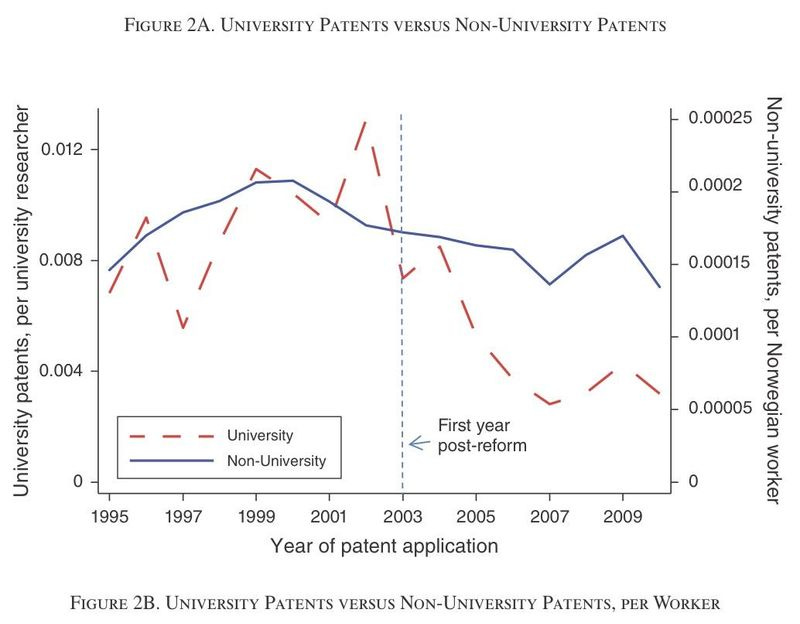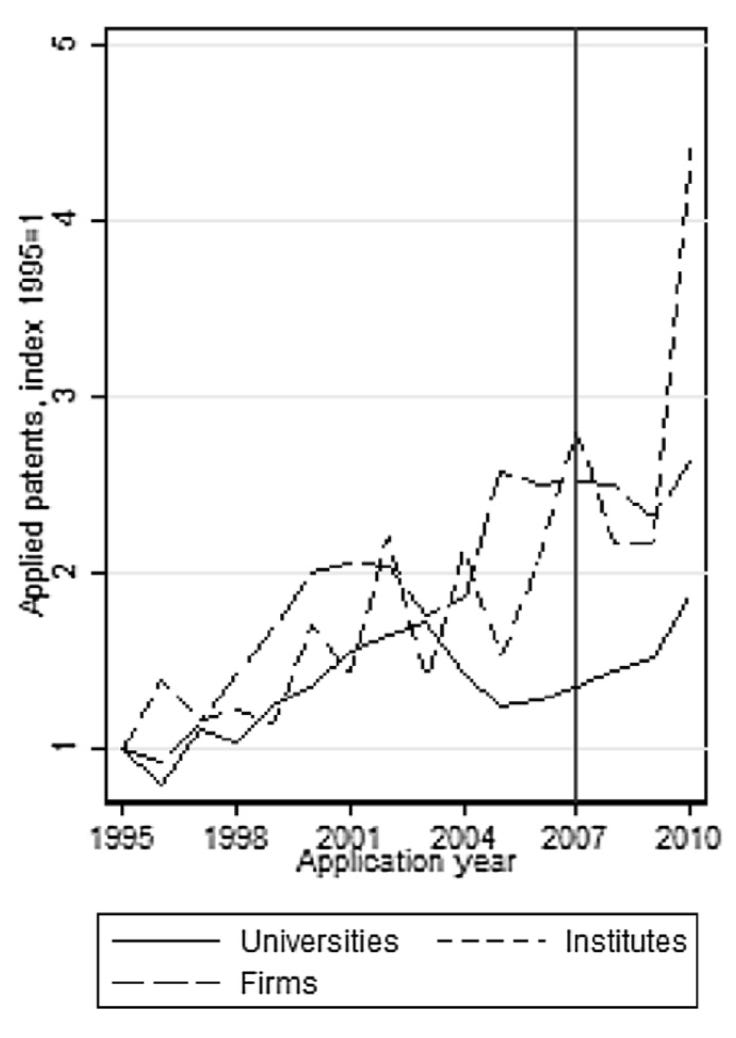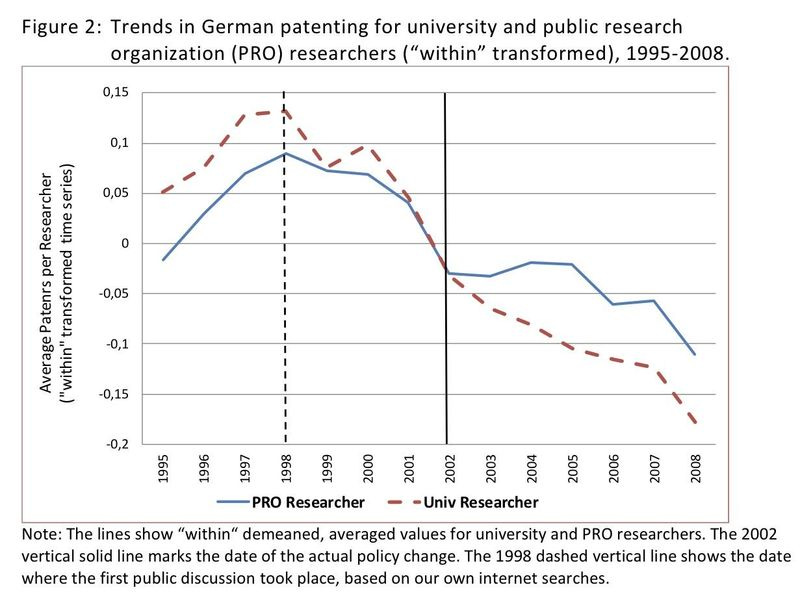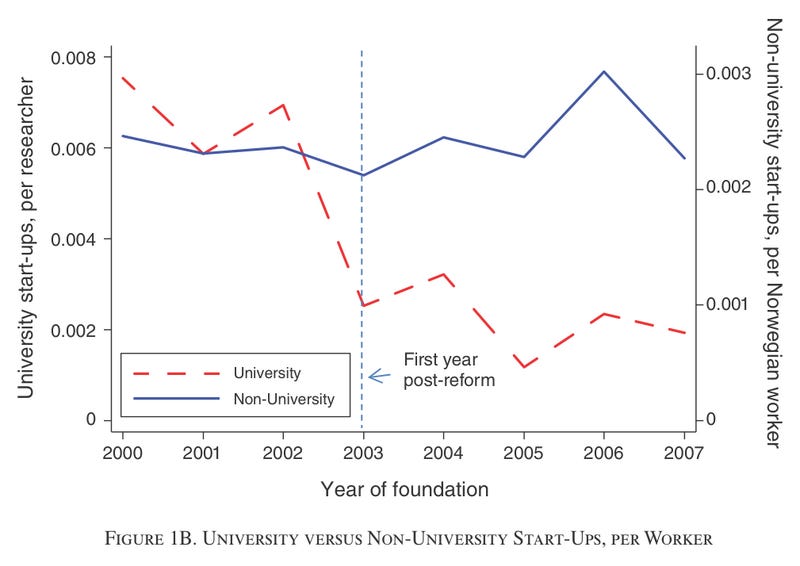Incentives to Invent at Universities
More complicated than it seems
This article will be updated as the state of the academic literature evolves; you can read the latest version here. A podcast version of me reading this post is late but will happen - subscribe if you don’t want to miss it.
Prior to the 2000s, many European countries practiced something called “the professor’s privilege” wherein university professors retained patent rights to inventions they made while employed at the university. This was a “privilege” because the norm is for patent ownership to be assigned to the organization that employs an inventor; professors were an exception to this norm. American universities, in contrast, had long followed a different approach, where patent rights were typically assigned to the university, who managed commercialization efforts. Professors then split the proceeds of commercializing their inventions with the university.
There had long been a sense that commercialization of university research worked better in America, and in the 2000s a number of European countries reformed their laws to move them closer in spirit to the American system. Professors lost their privilege and universities got more into the commercialization game.
If the goal of this reform was to encourage more professors to invent things that could be commercialized, several papers indicate this policy was a mistake.
Announcements
8th Annual Research Policy Online Conference for Early Career Researchers: Sponsored by the Research Policy journal. Apply to present by August 25.
Good Science Project request for R&D reform policy ideas: If selected, they will help you write a policy brief.
7th Annual Research on Innovation, Science and Entrepreneurship (RISE) Workshop: Organized by the Max Planck Institute for Innovation and Competition in Munich. Application deadline is July 26 (today!)
Email me to suggest an announcement for the next newsletter.
Declining Commercialization
Each of the following papers takes a conceptually straightforward strategy to evaluate the impact of dropping the professor’s privilege: look at how the number of university inventions per researcher changes before and after the policy change, as compared to some other group that was not affected by the policy change.
We’ll start with Hvide and Jones (2018), which looks at the impact of this policy in Norway. Hvide and Jones identify all the Norwegian patents granted to inventors with addresses in Norway - this includes university and non-university inventors. They then match the names of inventors to a list of the names of all Norwegian University researchers. In the figure below, they plot the average number of patents per researcher (red-dashed line, left-hand axis) and the average number of patents per non-university worker (solid blue line, right-hand axis). Following the 2003 cessation of the professor’s privilege, there was a sharp drop in the patenting rate among university researchers, but only a modest decline among non-university workers. All in all, Hvide and Jones estimate stripping university researchers of full patent rights led to a 50% reduction in their patenting rate.
Let’s next press on to Ejermo and Toivanen (2018), who study the same kind of policy in neighboring Finland. Finland adopted a similar policy in 2007, though it paired that policy with a substantial increase in funding to support commercialization efforts. Ejermo and Toivanen have a dataset listing the home address and employment of seemingly everyone in Finland, which lets them be quite confident in how they match patents to university or private sector businesses (or non-university public research institutes), since they can check that the listed address on the patent matches an individual’s listed home address. In the figure below, they compare how the number of patents from firms, universities, and public research institutes (which were not affected by the policy change) changed over 1995-2010. Patenting at the three institutions grew at a similar rate from 1995 to 2004, but then patenting at universities began to diverge to a permanently lower growth rate. Ejermo and Toivanen note the decline began in 2004, rather than 2007 when the policy was enacted, and suspect this is because discussion of the policy change started in the earlier year. Forward-looking university researchers realized that any patent applications they filed might not be granted before the policy became official, when their ownership rights would be given to the university. All in all, Ejermo and Toivanen estimate the policy reduced university researcher patenting by 29-46% relative to trends in the private sector, depending on whether they consider the policy as starting to have effect in 2004 or 2007.
Czarnitzki et al. (2017) examine the impact of a similar policy in 2002, down in Germany. In their case, they focus on comparing university researchers to researchers in non-university public research organizations, such as the Max Planck, Fraunhofer, and Helmholtz institutes. Inventors at these institutions never enjoyed default patent rights to their inventions, but were in other ways similar to university researchers (for example, both relied heavily on state funding). In the figure below, Czarnitzki and coauthors plot the average deviation of an individual researcher’s patents per year, over time. When the line is above zero, this figure is saying that, on average, a researcher tended to have more patents than they usually do in that year. Conversely, when the line is below zero, it means that is a year in which researchers tended to have fewer patents than their long-run average. The chart depicts a steady decline in patenting among university researchers, relative to their peers at non-university public research institutes. The years prior to 1998, before the policy had begun to be discussed, were relatively good ones for patenting among university researchers but not so abnormally good for researchers at public research organizations. The two kinds of institutions converged over 1998-2002, when the policy was debated. And after 2002, when the policy was enacted, university researcher patenting was abnormally low, relative to their long-run average, while patenting at public research organizations was not so unusually low. All in all, Czarnitzki and coauthors estimate the policy reduced university researcher patenting by about 17%.
Next, over to Denmark. Valentin and Lund Jensen (2007) obtains similar results in a study comparing university commercial research in Denmark (which dropped the professor’s privilege) to Sweden (which did not). Their context is a bit more narrow than the preceding papers; specifically, they look at collaborations between industry and university biotech researchers that result in patents. In this industry, it was relatively common for university researchers to partner with industry, with university researchers typically ceding their patent rights to industry partners. This negotiation got more complicated in the year 2000, when Denmark (but not Sweden) ended the professor’s privilege. Now, three parties - the university researcher, the industry partner, but now also the university itself - negotiated over patent rights. Valentin and Lund Jensen find that after Danish professor’s lost full rights to their patents in the year 2000, university-industry biotech collaborations in Demark declined, relative to Sweden: there were fewer patents owned by industry with a university inventor, and the increase in university patents was too small to offset this decline.
Before moving on, let’s circle back to the first paper we discussed, Hvide and Jones (2018). One issue with the results discussed so far is that they rely entirely on patent data.1 What these policy reforms ultimately cared about was not patenting but the commercialization of university research. Perhaps the drop in patenting doesn’t reflect a drop in actual commercialization; maybe all that these papers document is that professors rationally shift their commercialization efforts away from patents (which universities will own) to alternatives. Hvide and Jones deal with this by also looking at what happens to university startups after the policy change. After matching data in a national startup registry to employment data for the Norwegian population they look at the rate at which university researchers launch startups, relative to the general Norwegian population. As displayed in the figure below, this exercise tells us basically the same thing as the patent analysis: university startups, like university patenting, declined sharply after the end of the professor’s privilege, relative to trends outside the university sector.
With the startup data, Hvide and Jones have data on the educational background and sector of employment for most of the Norwegian population, which lets them tighten up their comparison group to PhD holders in the general population. But comparing startup rates between university professors and other PhDs in Norway generally obtains similar results.
Incentives Matter?
OK, so across these studies we find that when you move from a regime where university professor’s retain 100% of the rights of their patented inventions to a regime where the university owns the patents and pays professors a portion of royalties, then university professors begin to patent a lot less. While the magnitudes of the effect are perhaps surprisingly high (17-50%), in other ways this seems like a supremely non-surprising result: when there is less reward for doing something, people do less of that thing. Incentives matter.
But it doesn’t actually seem to be that simple.
First, if this is primarily a story about researchers responding to the size of the rewards to invention, then we should expect to see a positive correlation between the extent of patenting and the size of rewards in other contexts. If patenting goes down because you go from earning 100% of patent licensing fees to 33% when the professor’s privilege is abolished, then it should also be true that universities that gives researchers 25% of the royalties from their patents should see less patenting than those that give researchers 50%, all else equal.
That’s not Ouellette and Tutt (2020) find when they study the relationship between the patent policy of 152 American universities and patenting by faculty. Taking the average royalty share at a university over 1991-1999 and comparing across universities, there is no relationship between this measure and patenting or invention disclosures by faculty. Neither is there a relationship over 2000-2013. Universities may use complicated formulas for splitting patent profits which makes it tricky to estimate a single “royalty share”, but there is no relationship when Ouellette and Tutt try alternatives, or when they restrict their sample to universities that have simple splitting formulas. Perhaps the issue is that the size of royalties is negatively correlated with how much support there is for commercialization, so that the positive effect of a higher royalty share at a given university is perfectly offset by lower support for commercialization there? But Ouellette and Tutt also look to see if changes in a given university’s royalty share are followed by changes in patenting per researcher at that university. Again, no. Finally, Ouellette and Tutt look to see if faculty who patent a lot and change university tend to disproportionately move to universities that offer a higher share of patenting revenues to their faculty: they don’t.
Maybe the issue is just that the royalty share at American universities doesn’t move around very much? That seems unlikely too: by Ouellette and Tutt’s estimates, they span the 20%-80% interval.
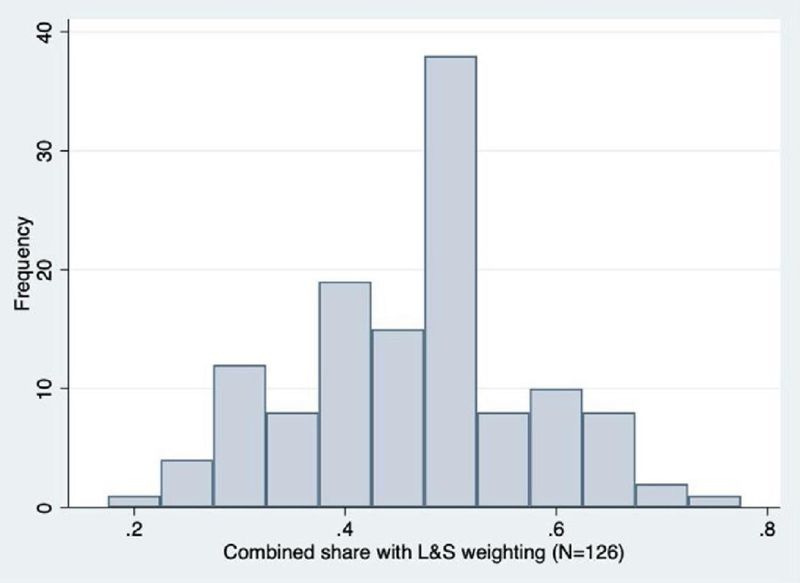
What’s going on here? Why did losing 100% of the rights to a patent lead to large drops in inventive activity across universities in Europe, but faculty at American universities seem completely indifferent to their share of patent profits?
A second line of evidence that this isn’t just down to “incentives matter” comes from Czarnitzki et al. (2017), discussed above. As noted previously, they find the overall effect of eliminating the professor’s privilege in Germany was to reduce patenting per university researcher. However, this overall effect conceals some interesting variation. In one analysis, Czarnitzki and coauthors identify university researchers who have been listed as an inventor on a patent owned by a private firm in industry; that’s an indication that the professor had some connections with industry. When they separate researchers with and without industry connections, they find that patenting among researchers with an industry connection fell about 23%. But among those who didn’t have a connection, patenting after the reform increased by 32%. The reason there was a net decline is because among patenting researchers, many more had industry connections than did not, at the time of the reform. Why would a decline in the royalties from patenting lead researchers without prior industry experience to seek more patents?
After thinking about all these different papers, here’s one working hypothesis (but email me if you have a better one!).
Maybe royalty rates don’t actually matter very much, because the returns to commercialization are distributed so unevenly. Most patents are not even worth paying the fees to keep them active for their full 20-year life, but a few are extremely valuable. So whether you earn 20% or 100% of the profits from commercialization, what really matters is if you have a big success or not. If you do, even a 20% share of that is a lot of money and fully justifies the commercialization effort.
In that case, what matters most for the decision to commercialize is whether you think you’ll succeed, not the share of royalties you get conditional on success. And maybe successful commercialization is more about things like “is there a network of entrepreneurial scientists who can advise you?” Or “is there a local VC scene?” Or “Do I know some people in industry who will pay for this research if I give them the patent?” If the environment is supportive of commercialization, you’ll go for it, with any influence of the royalty share too small for statistical tests to identify.
In Europe, during the era of the professor’s privilege, one of the most important questions was likely “how good am I at commercializing research?” The ones who chose to commercialize must have decided they were good enough. The ones who did not commercialize must have decided they lacked the skill (or interest). But following the reforms, commercialization leadership went to the university, and the relevant question became “how good are my university’s commercialization people?” Maybe some of the former commercializers answered this question as “not as good as me, and not good enough for it to be worth the effort.”2 Accordingly, patenting from these folks dropped. And maybe some of the researchers who formerly did not commercialize gave the opposite answer. These folks began to commercialize more, but since there weren’t many of them the net effect of transferring commercialization from the individual to the university was negative. Meanwhile, in the USA, commercialization has always been university-led, and so we don’t see any kind of similar story.
A Metascience Parable
Whatever the real story, I think this episode can also serve as a useful parable about improving the productivity of our research and innovation ecosystem. First off, it demonstrates that policy questions can be quantitatively important: the magnitudes of the effect of this policy change are strikingly large. University commercialization is a small part of overall technological progress, but it’s disproportionately likely to draw on frontier science, and so policies that affect it matter.
Second, it demonstrates that the right policy is not always obvious. In this case, it seems that several European countries decided they wanted better commercialization of university research, and so they looked to the perceived leader in commercialization (the USA) and copied some of its features. This seemingly straight-forward approach to designing policy didn’t work as anticipated - possibly the copied features only work in conjunction with other things the US has going for it; or maybe they don’t matter at all (or are actively bad), and US commercialization outcomes are down to something else entirely. When getting innovation policy right matters and is non-obvious, careful academic research can have a big social impact.
Thanks for reading! As always, if you want to chat about this post or innovation in generally, let’s grab a virtual coffee. Send me an email at matt@newthingsunderthesun.com and we’ll put something in the calendar.
For a lot more discussion on whether patents are a good measure of innovation, see Can we learn about innovation from patent data?
Or maybe they asked themselves “do my industry partners want to work with the university, instead of me?” And again answered in the negative.

